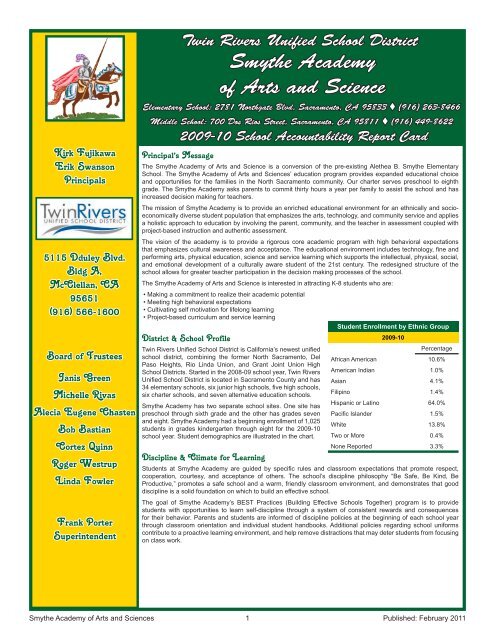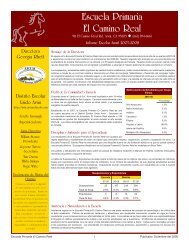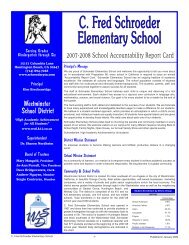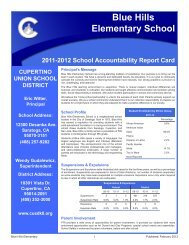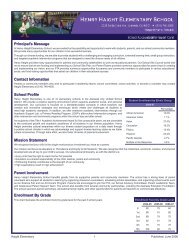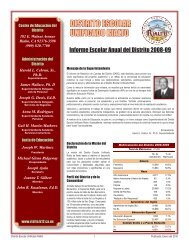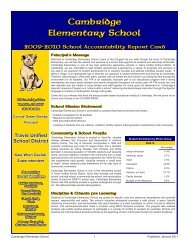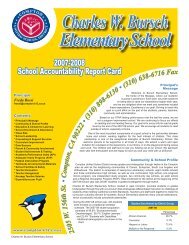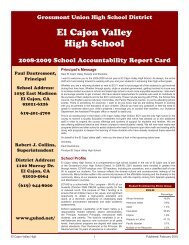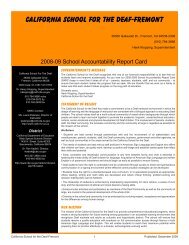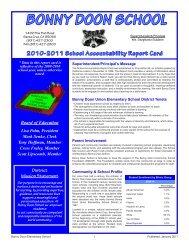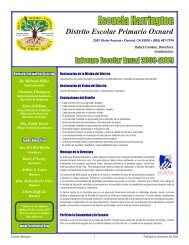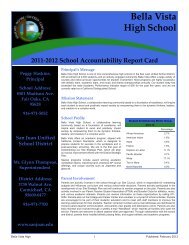Smythe 2009-10.indd - Axiomadvisors.net
Smythe 2009-10.indd - Axiomadvisors.net
Smythe 2009-10.indd - Axiomadvisors.net
You also want an ePaper? Increase the reach of your titles
YUMPU automatically turns print PDFs into web optimized ePapers that Google loves.
Kirk Fujikawa<br />
Erik Swanson<br />
Principals<br />
5115 Dduley Blvd.<br />
Bldg A,<br />
McClellan, CA<br />
95651<br />
(916) 566-1600<br />
Board of Trustees<br />
Janis Green<br />
Michelle Rivas<br />
Alecia Eugene Chasten<br />
Bob Bastian<br />
Cortez Quinn<br />
Roger Westrup<br />
Linda Fowler<br />
Frank Porter<br />
Superintendent<br />
Principal’s Message<br />
Twin Rivers Unified School District<br />
The <strong>Smythe</strong> Academy of Arts and Science is a conversion of the pre-existing Alethea B. <strong>Smythe</strong> Elementary<br />
School. The <strong>Smythe</strong> Academy of Arts and Sciences’ education program provides expanded educational choice<br />
and opportunities for the families in the North Sacramento community. Our charter serves preschool to eighth<br />
grade. The <strong>Smythe</strong> Academy asks parents to commit thirty hours a year per family to assist the school and has<br />
increased decision making for teachers.<br />
The mission of <strong>Smythe</strong> Academy is to provide an enriched educational environment for an ethnically and socioeconomically<br />
diverse student population that emphasizes the arts, technology, and community service and applies<br />
a holistic approach to education by involving the parent, community, and the teacher in assessment coupled with<br />
project-based instruction and authentic assessment.<br />
The vision of the academy is to provide a rigorous core academic program with high behavioral expectations<br />
that emphasizes cultural awareness and acceptance. The educational environment includes technology, fi ne and<br />
performing arts, physical education, science and service learning which supports the intellectual, physical, social,<br />
and emotional development of a culturally aware student of the 21st century. The redesigned structure of the<br />
school allows for greater teacher participation in the decision making processes of the school.<br />
The <strong>Smythe</strong> Academy of Arts and Science is interested in attracting K-8 students who are:<br />
• Making a commitment to realize their academic potential<br />
• Meeting high behavioral expectations<br />
• Cultivating self motivation for lifelong learning<br />
• Project-based curriculum and service learning<br />
District & School Profile<br />
Twin Rivers Unified School District is California’s newest unifi ed<br />
school district, combining the former North Sacramento, Del<br />
Paso Heights, Rio Linda Union, and Grant Joint Union High<br />
School Districts. Started in the 2008-09 school year, Twin Rivers<br />
Unified School District is located in Sacramento County and has<br />
34 elementary schools, six junior high schools, fi ve high schools,<br />
six charter schools, and seven alternative education schools.<br />
<strong>Smythe</strong> Academy has two separate school sites. One site has<br />
preschool through sixth grade and the other has grades seven<br />
and eight. <strong>Smythe</strong> Academy had a beginning enrollment of 1,025<br />
students in grades kindergarten through eight for the <strong>2009</strong>-10<br />
school year. Student demographics are illustrated in the chart.<br />
Discipline & Climate for Learning<br />
<strong>Smythe</strong> Academy<br />
of Arts and Science<br />
Elementary School: 2781 Northgate Blvd, Sacramento, CA 95833 (916) 263-8466<br />
Middle School: 700 Dos Rios Street, Sacramento, CA 95811 (916) 449-8622<br />
<strong>2009</strong>-10 School Accountability Report Card<br />
Student Enrollment by Ethnic Group<br />
<strong>2009</strong>-10<br />
Percentage<br />
African American 10.6%<br />
American Indian 1.0%<br />
Asian 4.1%<br />
Filipino 1.4%<br />
Hispanic or Latino 64.0%<br />
Pacific Islander 1.5%<br />
White 13.8%<br />
Two or More 0.4%<br />
None Reported 3.3%<br />
Students at <strong>Smythe</strong> Academy are guided by specifi c rules and classroom expectations that promote respect,<br />
cooperation, courtesy, and acceptance of others. The school’s discipline philosophy “Be Safe, Be Kind, Be<br />
Productive,” promotes a safe school and a warm, friendly classroom environment, and demonstrates that good<br />
discipline is a solid foundation on which to build an effective school.<br />
The goal of <strong>Smythe</strong> Academy’s BEST Practices (Building Effective Schools Together) program is to provide<br />
students with opportunities to learn self-discipline through a system of consistent rewards and consequences<br />
for their behavior. Parents and students are informed of discipline policies at the beginning of each school year<br />
through classroom orientation and individual student handbooks. Additional policies regarding school uniforms<br />
contribute to a proactive learning environment, and help remove distractions that may deter students from focusing<br />
on class work.<br />
<strong>Smythe</strong> Academy of Arts and Sciences 1<br />
Published: February 2011
The Suspensions and Expulsions table illustrates the unduplicated number<br />
of students suspended as well as the percentage of enrollment (students<br />
suspended divided by enrollment). Expulsions occur only when required by<br />
law or when all other alternatives are exhausted. Since the district opened<br />
in the 2008-09 school year there is no district data reported for one of the<br />
last three years. Being a new district it would not be appropriate to assign<br />
the performance of any of the old districts to the new district.<br />
Suspensions & Expulsions<br />
School<br />
District<br />
07-08 08-09 09-10 07-08 08-09 09-10<br />
Suspensions 163 160 35 0 10898 6864<br />
Suspension Rate 15.6% 16.2% 3.4% 0.0% 35.2% 22.0%<br />
Expulsions 2 0 1 0 64 52<br />
Expulsion Rate 0.2% 0.0% 0.1% 0.0% 0.2% 0.2%<br />
Recognition Program<br />
<strong>Smythe</strong> Academy’s comprehensive student recognition program<br />
contributes to the positive environment of the school, and includes<br />
classroom and school-wide awards. Assemblies are held each trimester<br />
to recognize students for Honor Roll, Perfect Attendance, and to give out<br />
classroom awards in Math, Reading, Language and Attitude. Students<br />
exhibiting positive behavior, attendance, and effort are eligible to become<br />
one of “<strong>Smythe</strong>’s Shining Knights.”<br />
Extracurricular Activities<br />
<strong>Smythe</strong> Academy recognizes that extracurricular activities enrich the<br />
educational and social development and experiences of students. The<br />
district encourages and supports student participation in extracurricular<br />
activities without compromising the integrity and purpose of the educational<br />
program. Extracurricular activities include:<br />
Elementary School:<br />
• Honor Roll<br />
• Shining Knights<br />
• Family Reading & Science Nights<br />
• Exploratory Showcase<br />
Middle School<br />
• Student Government<br />
• MASTERS Program<br />
• Band<br />
• Competitive Soccer<br />
• Basketball<br />
• Track & Field<br />
• Golf<br />
• Flag Football<br />
• Volleyball<br />
• Power Hour<br />
School Enrollment & Attendance<br />
School districts receive financial support from the state for the education<br />
of the students they serve based on how many students attend each<br />
day. Most importantly, attendance is critical to academic achievement<br />
and regular daily attendance is a priority at <strong>Smythe</strong> Academy of Arts and<br />
Sciences. Student attendance is carefully monitored to identify those<br />
students exhibiting excessive absences.<br />
Attendance, tardy, and truancy policies are clearly stated, consistently<br />
enforced, and consequences fairly administered. Parents are advised<br />
of their responsibilities, including proper notification of when and why<br />
students are absent. The school monitors student attendance very closely,<br />
makes phone calls to parents on a daily basis, and will send letters home if<br />
absences become a problem.<br />
Students are referred to the School Attendance Review Board (SARB)<br />
when they have persistent attendance and behavior problems in school,<br />
and when the normal avenues of classroom, school, and district counseling<br />
are not effective.<br />
This chart illustrates the enrollment trend by grade level for the past three<br />
school years.<br />
Class Size<br />
Average class sizes vary by grade level and subject area taught. The table<br />
indicates the average class size by grade level or subject area, as well as<br />
the number of classes offered in reference to their enrollment.<br />
Class Size Reduction<br />
Enrollment Trend by Grade Level<br />
2007-08 2008-09 <strong>2009</strong>-10<br />
K 81 77 76<br />
1st 106 83 80<br />
2nd 91 92 76<br />
3rd 100 84 92<br />
4th 88 79 80<br />
5th 96 78 80<br />
6th 79 88 85<br />
7th 206 238 231<br />
8th 195 169 225<br />
Class Size Distribution<br />
Classrooms Containing:<br />
Average<br />
Class Size<br />
1-20<br />
Students<br />
21-32<br />
Students<br />
In 1996, state legislature approved implementation of the Class Size<br />
Reduction (CSR) program that provides funding to hire additional teachers<br />
to assist schools in reducing K-3 class sizes. <strong>Smythe</strong> Academy began<br />
implementing CSR for grades kindergarten through three in 1996-1997.<br />
The table displays the percentage of K-3 classrooms that participated in<br />
CSR for the past three school years.<br />
CSR Participation<br />
2007-08 2008-09 <strong>2009</strong>-10<br />
K 100% 100% 0%<br />
1 100% 100% 0%<br />
2 100% 100% 0%<br />
3 100% 100% 0%<br />
33+<br />
Students<br />
08 09 10 08 09 10 08 09 10 08 09 10<br />
By Grade Level<br />
K 20 20 24 5 5 - - - 3 - - -<br />
1 20 20 24 5 4 - - - 3 - - -<br />
2 20 18 24 4 5 - - - 3 - - -<br />
3 20 20 22 4 4 - - - 4 - - -<br />
4 28 22 31 - 1 - 3 3 2 - - -<br />
5 28 25 30 - - - 2 2 2 - - -<br />
6 28 24 27 - 1 - 3 2 3 - - -<br />
K-3 19 - - 1 - - - - - - - -<br />
4-8 27 - 30 - - - 1 - 1 - - -<br />
By Subject Area<br />
English 22 21 25 9 13 2 11 9 15 - - -<br />
Mathematics 22 22 25 9 8 2 10 11 15 - - 1<br />
Science 25 24 26 3 6 - 13 9 15 - 1 1<br />
Social Science 23 22 26 6 9 1 11 10 15 - - -<br />
<strong>Smythe</strong> Academy of Arts and Sciences 2<br />
Published: February 2011
Curriculum Development<br />
All curriculum development in the Twin Rivers Unified<br />
School District is based on the California State Content<br />
Standards and Frameworks. Curriculum guides are<br />
updated regularly, to align with the state standards, district<br />
goals, and the statewide assessment program.<br />
Instructional Materials<br />
Twin Rivers Unified School District held a public hearing<br />
in October <strong>2009</strong>, and determined that each school within<br />
the district had sufficient and good quality textbooks,<br />
instructional materials, and science lab equipment pursuant<br />
to the settlement of Williams vs. the State of California. All<br />
students, including English learners, are given their own<br />
individual standards-aligned textbooks or instructional<br />
materials, or both, in core subjects for use in the classroom<br />
and to take home. Textbooks and supplementary<br />
materials are adopted according to a cycle developed<br />
by the California Department of Education, making the<br />
textbooks used in the school the most current available.<br />
Materials approved for use by the State are reviewed by<br />
teachers and a recommendation is made to the School<br />
Board by a selection committee composed of teachers and<br />
administrators. All teachers have the opportunity to review<br />
the materials. All recommended materials are available for<br />
parent examination at the district office prior to adoption.<br />
The table displays information about the quality, currency,<br />
and availability of the standards-aligned textbooks and<br />
other instructional materials used at the school.<br />
Additional Inter<strong>net</strong> Access/Public Libraries<br />
For additional research materials and Inter<strong>net</strong> availability,<br />
students are encouraged to visit the public libraries located<br />
in the city and county of Sacramento, which contain<br />
numerous computer workstations. Visit www.saclibrary.org<br />
for more information and directions to the nearest branch.<br />
Grade<br />
Levels<br />
7th<br />
8th<br />
K-6<br />
6th<br />
K-5<br />
Subject<br />
English<br />
Language<br />
Development<br />
English<br />
Language<br />
Development<br />
English/<br />
Language Arts<br />
History/Social<br />
Studies<br />
History/Social<br />
Studies<br />
District-Adopted Textbooks<br />
Publisher<br />
Adoption<br />
Year<br />
Sufficient<br />
% Lacking<br />
Holt 2006 Yes 0.0%<br />
Holt 2007 Yes 0.0%<br />
Open Court 2002 Yes 0.0%<br />
MacMillan/<br />
McGraw Hill<br />
Pearson Scott<br />
Foresman<br />
2006 Yes 0.0%<br />
2006 Yes 0.0%<br />
K-6 Mathematics<br />
Pearson Scott<br />
Foresman<br />
<strong>2009</strong> Yes 0.0%<br />
7th Mathematics Prentice Hall 2006 Yes 0.0%<br />
8th Mathematics Prentice Hall 2007 Yes 0.0%<br />
7th Science Holt 2006 Yes 0.0%<br />
6th<br />
Science<br />
Houghton<br />
Mifflin<br />
2007 Yes 0.0%<br />
K-5 Science<br />
Pearson Scott<br />
Foresman<br />
2007 Yes 0.0%<br />
8th Science Prentice Hall 2007 Yes 0.0%<br />
7th<br />
8th<br />
Social<br />
Science/<br />
History<br />
Social<br />
Science/<br />
History<br />
Teacher’s<br />
Curriculum<br />
Institute<br />
Teacher’s<br />
Curriculum<br />
Institute<br />
2006 Yes 0.0%<br />
2007 Yes 0.0%<br />
Counseling & Support Staff<br />
It is the goal of <strong>Smythe</strong> Academy to assist students in their social and personal<br />
development as well as academics. The goal is to help students deal with problems and<br />
assist them to reach positive goals. When students require additional assistance the<br />
following support staff are available according to the full-time equivalent indicated in the<br />
chart.<br />
<strong>Smythe</strong> Academy utilizes supplemental instruction, Resource Specialists, and Learning<br />
Development classes for students with special needs. A Speech & Language Therapist<br />
provides additional support outside of traditional classrooms.<br />
A Gifted and Talented Education (GATE) program is available for those students that<br />
qualify, where students receive challenging supplemental instruction.<br />
Physical Fitness<br />
In the spring of each year, <strong>Smythe</strong> Academy of Arts and Sciences School is required by<br />
the state to administer a physical fitness test to all students in fi fth grade. The physical<br />
fi tness test is a standardized evaluation that measures each student’s ability to perform<br />
fi tness tasks in six major areas. Students that meet or exceed the standards in all six<br />
fi tness areas are considered to be physically fit or in the healthy fi tness zone (HFZ).<br />
*<strong>2009</strong>-10 scores were not released by the CDE at the time of publication.<br />
Counseling & Support Services Staff<br />
Number of<br />
Staff<br />
Full Time<br />
Equivalent<br />
Academic Counselor 1 1.0<br />
English Language<br />
Resource Teacher<br />
1 1.0<br />
Library Clerk 1 0.75<br />
Music Teacher 1 0.333<br />
Nurse 1 0.33<br />
Outreach Consultant 1 1.0<br />
Psychologist 1 0.5<br />
Resource Specialist<br />
Program (RSP) Teacher<br />
1 1.0<br />
RSP Aide 2 1.5<br />
SDC Aide 2 1.5<br />
Special Day Class<br />
(SDC) Teacher<br />
2 2.0<br />
Speech and Language<br />
Specialist<br />
1 0.5<br />
<strong>Smythe</strong> Academy of Arts and Sciences 3<br />
Published: February 2011
California Standards Test<br />
The California Standards Test (CST), a component of the STAR Program, is administered to all students in the spring to assess student performance<br />
in relation to the State Content Standards. Student scores are reported as performance levels: Advanced (exceeds state standards), Profi cient (meets<br />
standards), Basic (approaching standards), Below Basic (below standards), and Far Below Basic (well below standards). The combined percentage of<br />
students scoring at the Proficient and Advanced levels in English/Language Arts, Math, and Science, for the most recent three-year period, is shown.<br />
Since the district opened in the 2008-09 school year there is no district data reported for one of the last three years. Being a new district it would not<br />
be appropriate to assign the performance of any of the old districts to the new district. For results on course specifi c tests, please see http://star.cde.<br />
ca.gov.<br />
California Standards Test (CST)<br />
Subject School District State<br />
2008 <strong>2009</strong> 2010 2008 <strong>2009</strong> 2010 2008 <strong>2009</strong> 2010<br />
English/Language Arts 36 40 43 44 38 39 46 50 52<br />
Mathematics 31 42 50 49 35 40 43 46 48<br />
Science 46 50 64 43 34 39 46 50 54<br />
History/Social Science 26 41 48 41 25 27 36 41 44<br />
*Scores are not disclosed when fewer than 10 students are tested in a grade level and/or subgroup.<br />
Subject<br />
California Standards Test (CST)<br />
Subgroups<br />
English/<br />
Language<br />
Arts<br />
Mathematics<br />
Science<br />
History/<br />
Social<br />
Science<br />
District 39 40 39 27<br />
School 43 50 64 48<br />
African American 45 39 66 61<br />
American Indian * * * *<br />
Asian 61 61 57 *<br />
Filipino * * * *<br />
Hispanic or Latino 38 48 61 43<br />
Pacific Islander 33 58 * *<br />
White 57 62 73 53<br />
Males 40 49 66 49<br />
Females 46 51 61 47<br />
Socioeconomically<br />
Disadvantaged<br />
42 49 63 46<br />
English Learners 20 34 41 18<br />
Students with<br />
Disabilities<br />
39 38 40 24<br />
Migrant Education * * * *<br />
*Scores are not disclosed when fewer than 10 students are tested in a grade level<br />
and/or subgroup.<br />
Federal Intervention Program<br />
Schools and districts receiving Federal Title I funding enter Program Improvement (PI) if they do not make AYP for two consecutive years in the same<br />
content area (English/Language Arts or Mathematics) or on the same indicator (API or graduation rate). After entering PI, schools and districts advance<br />
to the next level of intervention with each additional year that they do not make AYP. Since the district opened in the 2008-09 school year there is no<br />
district data reported for one of the last three years. Being a new district it would not be appropriate to assign the performance of any of the old districts<br />
to the new district.<br />
Federal Intervention Programs<br />
School District<br />
Program Improvement (PI) Status In PI In PI<br />
First Year in PI <strong>2009</strong>-2010 2010-2011<br />
Year in PI (2010-11) Year 2 Year 1<br />
# of Schools Currently in PI - 35<br />
% of Schools Identified for PI - 61.40%<br />
<strong>Smythe</strong> Academy of Arts and Sciences 4<br />
Published: February 2011
Academic Performance Index<br />
The Academic Performance Index (API) is a score on a scale of 200 to 1,000 that annually<br />
measures the academic performance and progress of individual schools in California. The state<br />
has set 800 as the API score that schools should strive to meet.<br />
Statewide Rank: Schools receiving an API Base score are ranked in ten categories of equal size<br />
(deciles) from 1 (lowest) to 10 (highest), according to type of school (elementary, middle, or high<br />
school).<br />
Similar Schools Rank: Schools also receive a ranking that compares that school to 100 other<br />
schools with similar demographic characteristics. Each set of 100 schools is ranked by API<br />
score from 1 (lowest) to 10 (highest) to indicate how well the school performed compared to<br />
similar schools.<br />
The table to the right displays the school’s API ranks and actual API point changes by student<br />
group for the past three years.<br />
The table below displays, by student group, the most recent Growth API at the school, district,<br />
and state level.<br />
Growth API<br />
School District State<br />
All Students at the School 765 725 767<br />
Hispanic or Latino 747 708 715<br />
White 834 765 838<br />
Socioeconomically Disadvantaged 757 713 712<br />
English Learners 729 709 692<br />
API School Results<br />
07-08 08-09 09-10<br />
Statewide - - 3<br />
Similar Schools - - 6<br />
All Students at the School<br />
Actual API Change - 38 26<br />
Hispanic or Latino<br />
Actual API Change - 38 15<br />
White<br />
Actual API Change - 18 109<br />
Two or More Races<br />
Actual API Change - - 0<br />
Socioeconomically Disadvantaged<br />
Actual API Change - 37 25<br />
English Learners<br />
Actual API Change - 40 22<br />
* Statewide and similar schools ranks are based<br />
on the first year listed. (Example: the 07-08 rank<br />
reflects testing from Spring 2007.)<br />
Adequate Yearly Progress<br />
No Child Left Behind (NCLB) is a federal law enacted in January 2002 that reauthorized the Elementary and Secondary Education Act (ESEA). It<br />
mandates that all students (including students who are economically disadvantaged, are from racial or ethnic minority groups, have disabilities, or have<br />
limited English proficiency) in all grades meet the state academic achievement standards for Mathematics and English/Language Arts by 2014. Schools<br />
must demonstrate “Adequate Yearly Progress” (AYP) toward achieving that goal. The Federal NCLB Act requires that all schools and districts meet the<br />
following Adequate Yearly Progress (AYP) requirements:<br />
• Participation rate on the state’s standards-based assessments in English/Language Arts (ELA) and Mathematics.<br />
• Percent proficient on the state’s standards-based assessments in ELA and mathematics.<br />
• API as an additional indicator.<br />
• Graduation rate (for secondary schools).<br />
Adequate Yearly Progress (AYP)<br />
There are several consequences for schools that do not meet the<br />
AYP standards, including additional tutoring and replacing of staff.<br />
Students would also be allowed to transfer to schools (within their<br />
district) that have met their AYP, and the former school would be<br />
required to provide the transportation to the new site. Results of<br />
school and district performance are displayed in the chart. Since<br />
the district opened in the 2008-09 school year there is no district<br />
data reported for one of the last three years. Being a new district<br />
it would not be appropriate to assign the performance of any of<br />
the old districts to the new district.<br />
Teacher Assignment<br />
Twin Rivers Unified recruits and employs the most qualified credentialed teachers.<br />
School<br />
District<br />
Made AYP Overall No No<br />
Met AYP Criteria<br />
English -<br />
Language<br />
Arts<br />
Mathematics<br />
English -<br />
Language<br />
Arts<br />
Mathematics<br />
Participation Rate Yes Yes Yes Yes<br />
Percent Proficient No Yes No No<br />
API School Results Yes Yes<br />
Graduation Rate N/A Yes<br />
Teacher Credential Status<br />
School<br />
District<br />
07-08 08-09 09-10 09-10<br />
Fully Credentialed 52 53 45 1131<br />
Without Full Credentials 2 2 1 27<br />
Working Outside Subject 0 0 0 3<br />
<strong>Smythe</strong> Academy of Arts and Sciences 5<br />
Published: February 2011
Teacher misassignments reflect the number of placements within a school<br />
for which the certificated employee in the teaching or services position<br />
(including positions that involve teaching English Learners) does not hold<br />
a legally recognized certificate or credential. Teacher vacancies refl ect the<br />
number of positions to which a single designated certificated employee has<br />
not been assigned at the beginning of the year for an entire year.<br />
Highly Qualified Teachers<br />
The Federal No Child Left Behind Act requires that all teachers in core subject areas meet certain requirements in order to be considered as “Highly<br />
Qualified” no later than the end of the 2006-07 school year. Minimum qualifi cations include: possession of a Bachelor’s Degree, possession of an<br />
appropriate California teaching credential, and demonstrated competence in core academic subjects.<br />
NCLB Compliant Teachers<br />
% of Core<br />
Academic<br />
Courses<br />
Taught<br />
By NCLB<br />
Compliant<br />
Teachers<br />
% of Core<br />
Academic<br />
Courses<br />
Taught By<br />
Non-NCLB<br />
Compliant<br />
Teachers<br />
School 100.0% 0.0%<br />
District 98.0% 2.0%<br />
High-Poverty Schools in District 98.0% 2.0%<br />
Low-Poverty Schools in District N/A N/A<br />
Misassignments/Vacancies<br />
08-09 09-10 10-11<br />
Misassignments of Teachers of English Learners 0 0 0<br />
Misassignments of Teachers (other) 0 2 0<br />
Total Misassignments of Teachers 0 2 0<br />
Vacant Teacher Positions 0 0 0<br />
Teacher Evaluation & Professional Development<br />
A constructive evaluation process promotes quality instruction and is a fundamental element in a sound educational program. Evaluations and formal<br />
observations are designed to encourage common goals and to comply with the state’s evaluation criteria and district policies. Temporary and probationary<br />
teachers are evaluated annually and tenured teachers are evaluated every other year.<br />
Evaluations are conducted by an administrator, who has been trained and certifi ed for competency to perform teacher evaluations. Evaluation criteria<br />
are: Demonstrates Effective Instructional Techniques and Strategies, Establishes and Maintains Suitable Learning Environment, Adherence to District<br />
Curricular Objectives, Promotes Students’ Progress Toward District Standards of Expected Student Achievement, Fulfi lls Instructional Duties and<br />
Professional Responsibilities.<br />
Teachers and other certificated staff build skills and develop educational concepts through participation in conferences and workshops throughout the<br />
year. In the <strong>2009</strong>-2010 school year, Twin Rivers District offered 2 non-student professional development days for elementary teachers and secondary<br />
teachers. Professional development sessions focused on curriculum content (in particular the new K-6 Math program) and 7 specifi c focus areas to reach<br />
District goals to increase student achievement: Differentiating Instruction, 21st Century Skills, Increasing Parent Involvement, Student Interventions,<br />
Integrating the Arts, Teaching English Learners and Culturally Responsive Instruction.<br />
School Leadership<br />
Leadership at <strong>Smythe</strong> Academy is a responsibility shared between district administration, the principals, instructional staff, students, and parents. Primary<br />
leadership duties for the elementary school are assumed by Principal Kirk Fujikawa, who has been in his current position for 15 years. Prior to his tenure<br />
as the principal of <strong>Smythe</strong> Academy, Mr. Fujikawa was a Programs Facilitator for ten years and a classroom teacher for eight years.<br />
Primary leadership duties for the middle school are assumed by Principal Erik Swanson, who has been in his current position for 5 years. Mr. Swanson<br />
has 13 years of experience in education.<br />
The education of children is a joint effort of home and school. Students, parents and teachers meet each trimester to plan, discuss and evaluate student<br />
objectives. These objectives enable teachers to adjust their teaching to the unique needs of each class. Staff and parents are encouraged to participate<br />
in a wide variety of leadership teams, such as the School Site Council, the Leadership Team, the English Learners Advisory Committee and the Student<br />
Success Team.<br />
The <strong>Smythe</strong> Academy Site Council is a committee of parents and staff that reviews the total school program on an annual basis. This group leads the<br />
school in efforts to provide the best program for students. The Leadership Team is the primary body assigned to developing, refi ning, and implementing<br />
the school plan. Responsibilities of the Leadership Team include planning and monitoring the effectiveness of the school curriculum. Other leadership<br />
opportunities at <strong>Smythe</strong> Academy include the Safety Committee, the Coordination of Services Team, BEST Practices Committee, Board of Governors,<br />
Enrichment Committee, Parent Comittee, and Art Committee.<br />
Parent Involvement<br />
Parent Involvement: Parents and the community are very supportive of the educational programs in the Twin Rivers Unifi ed School District. The Parent<br />
Teacher Organization (PTO) plays an active role in the community and at each school site through fundraising and special activities. Contributions by<br />
Mim’s Café, El Pollo Loco, the Dream Project, and Stanford Settlement add to the programs available at <strong>Smythe</strong> Academy.<br />
Contact Information<br />
Parents who wish to participate in <strong>Smythe</strong> Academy’s leadership teams, school committees, school activities, or become a volunteer may contact the<br />
K-6 school’s office at (916) 263-8466 or the 7th-8th grade school’s offi ce at (916) 449-8622.<br />
<strong>Smythe</strong> Academy of Arts and Sciences 6<br />
Published: February 2011
School Facilities & Safety<br />
The elementary school facilities were built in 1948, and consist of 11 permanent classrooms, 23 portable classrooms, one multipurpose room, one library,<br />
two administrative buildings, one computer lab, one staff room, and one playground.<br />
The middle school facilities consist of seven permanent classrooms, 11 portable classrooms, a multipurpose room, a library, a computer lab, and a staff<br />
room.<br />
District administration and the Twin Rivers Board of Trustees<br />
have placed a great emphasis on campus safety and<br />
security. Teachers supervise students on campus before and<br />
after school and during recess, and noon duty supervisors<br />
monitor students during lunchtime. All visitors must sign in<br />
at the principal’s office and receive proper authorization to<br />
be at the school. Visitors are asked by the school site staff to<br />
display their pass at all times.<br />
<strong>Smythe</strong> Academy’s Safety Plan was reviewed February <strong>2009</strong><br />
by the Site Safety Committee, which is comprised of the<br />
principals, head custodian, secretary, Outreach Consultant,<br />
Learning Coordinator, and computer teacher. Emergency<br />
drills are held on a regular basis; fire drills are held once a<br />
month; earthquake and lockdown drills are held three times<br />
a year.<br />
The table shows the results of the most recent school<br />
facilities inspection. While reviewing this report, please note<br />
that even minor discrepancies are reported in the inspection<br />
process. The items noted in the table have been corrected or<br />
are in the process of remediation.<br />
Cleaning Process and Schedule<br />
The district governing board has adopted cleaning standards<br />
for all schools in the district. All schools are on a regular<br />
cleaning schedule. Each classroom is swept or vacuumed<br />
and the trash emptied. The cafeteria, gym, and all restrooms<br />
are cleaned daily. Grounds are groomed on a rotating basis,<br />
with trash, lawn, and plumbing issues addressed daily.<br />
Maintenance and Repair<br />
District maintenance staff ensures that the repairs necessary<br />
to keep the school in good repair and working order are<br />
completed in a timely manner. Four full-time and one parttime<br />
custodians ensure that all classrooms and facilities<br />
are in adequate condition. A work order process is used to<br />
ensure efficient service that emergency repairs are given the<br />
highest priority. At the time of publication, 100% of restrooms<br />
are in complete working order.<br />
Deferred Maintenance Budget<br />
The district participates in the State School Deferred<br />
Maintenance Program, which provides state matching<br />
funds on a dollar-for-dollar basis, to assist school districts<br />
with expenditures for major repair or replacement of existing<br />
school building components. Typically, this includes roofing,<br />
plumbing, heating, air conditioning, electrical systems, paving<br />
and fl oor systems. For the 2010-11 school year, the district<br />
has budgeted $790,000.00 for the deferred maintenance<br />
program. This represents 0.34% of the district’s general fund<br />
budget. Please see the district for a complete list of deferred<br />
maintenance projects.<br />
Items Inspected<br />
Systems (Gas Leaks, Mech/<br />
HVAC, Sewer)<br />
Interior<br />
Cleanliness (Overall<br />
Cleanliness, Pest/Vermin<br />
Infestation)<br />
Electrical<br />
Restrooms/Fountains<br />
Safety (Fire Safety,<br />
Hazardous Materials)<br />
Structural (Structural<br />
Damage, Roofs)<br />
External (Grounds, Windows,<br />
Doors, Gates, Fences)<br />
School Facility Conditions<br />
Date of Last Inspection: 08/21/<strong>2009</strong><br />
Overall Summary of School Facility Conditions: Good<br />
Facility Component<br />
System Status<br />
Good Fair Poor<br />
X<br />
X<br />
X<br />
X<br />
X<br />
X<br />
X<br />
X<br />
Deficiency & Remedial<br />
Actions Taken or Planned<br />
7-8 Campus-Rm 23 &<br />
24 - Replace floor tile. 7-8<br />
Campus-Rm 29 - Clean<br />
carpet. 7-8 Campus-Rm<br />
25 - Carpet needs cleaning.<br />
Elementary Campus-Room<br />
3 - Stained ceiling tiles.<br />
Elementary Campus-Room<br />
10 - Stained ceiling tiles.<br />
Elementary Campus-Room<br />
12 - Stained ceiling tiles.<br />
Elementary Campus-Room<br />
31 - Missing ceiling tile.<br />
Elementary Campus-Room<br />
34 - Missing ceiling tile.<br />
7-8 Campus-Rm 13 & 14<br />
- Bulbs out. 7-8 Campus-<br />
MP Hall - Lights out. 7-8<br />
Campus-Room 8 - Lights out.<br />
7-8 Campus-Kitchen - Light<br />
out. 7-8 Campus-Rm 23 & 24<br />
- Light out. 7-8 Campus-Rm<br />
32 - Light out. 7-8 Campus-<br />
Rm 29 - Light out. 7-8<br />
Campus-Rm 27 - Light out.<br />
Elementary Campus-Room<br />
12 - 1 light out. Elementary<br />
Campus-Room 31 - 2 lights<br />
out. Broken light cover.<br />
Elementary Campus-Multi<br />
Purpose Room - 3 lights out.<br />
School Site Teacher Salaries<br />
The chart illustrates the average teacher salary at the school and compares it to the average teacher<br />
salary at the district and state (based on FY 2008-09 financial statements).<br />
Average Teacher Salaries<br />
School & District<br />
School $60,564<br />
District $62,378<br />
Percentage of Variation 2.91%<br />
School & State<br />
All Unified School Districts $68,179<br />
Percentage of Variation 11.17%<br />
<strong>Smythe</strong> Academy of Arts and Sciences 7<br />
Published: February 2011
Teacher & Administrative Salaries<br />
This table displays district salaries for teachers, principals, and superintendents, and compares these fi gures to the state averages for districts of the<br />
same type and size. The table also displays teacher and administrative salaries as a percent of the districts budget, and compares these fi gures to the<br />
state averages for districts of the same type and size. Detailed information regarding salaries may be found at the CDE Web site, www.cde.ca.gov.<br />
Average Salary Information<br />
Teachers - Principal - Superintendent<br />
2008-09<br />
District State<br />
Beginning Teachers $40,000 $42,377<br />
Mid-Range Teachers $60,444 $67,667<br />
Highest Teachers $83,404 $87,102<br />
Elementary School Principals $102,853 $108,894<br />
Middle School Principals $105,554 $113,713<br />
High School Principals $116,331 $124,531<br />
Superintendent $200,281 $223,323<br />
Salaries as a Percentage of Total Budget<br />
Teacher Salaries 39.3% 40.3%<br />
Administrative Salaries 7.2% 5.5%<br />
Expenditures & Services Funded<br />
Based on 2008-09 FY audited financial statements, the table provides a comparison<br />
of a school’s per pupil funding from unrestricted sources with other schools throughout<br />
the state.<br />
In addition to general state funding, Twin Rivers Unified School District receives state<br />
and federal funding for the following categorical funds and other support programs:<br />
• Targeted Instruction Improvement Block Grant**<br />
• PE Block Grant**<br />
• School and Library Improvement Block Grant**<br />
• EIA-LEP<br />
• Gifted and Talented Education<br />
• EIA-SCE<br />
• Comprehensive Student Support<br />
• Healthy Start<br />
• Quality Education Investment Act<br />
• Medi-Cal<br />
• After School Education & Safety<br />
• Head Start<br />
• School Counselor Program<br />
• State Lottery<br />
• English Language Acquisition Program<br />
• Title IV<br />
• Parent Involvement<br />
• Title I<br />
• Charter School Fund<br />
• Title III<br />
• Reading First<br />
• State Compensatory Education<br />
• Pupil Retention Block Grant<br />
Expenditures per Pupil<br />
School<br />
Total Expenditures Per Pupil $7,075<br />
From Restricted Sources $1,153<br />
From Unrestricted Sources $5,922<br />
District<br />
From Unrestricted Sources $4,815<br />
Percentage of Variation between School & District 22.99%<br />
State<br />
From Unrestricted Sources $5,681<br />
Percentage of Variation between School & State 4.24%<br />
Data Sources<br />
Data within the SARC was provided by Twin Rivers Unified School District, retrieved from the <strong>2009</strong>-10 SARC template, and/or located on Dataquest<br />
(http://data1.cde.ca.gov/dataquest). Dataquest is a search engine, maintained by the California Department of Education (CDE), which allows the public<br />
to search for facts and figures pertaining to schools and districts throughout the state. Among the data available, parents and community may fi nd<br />
information about school performance, test scores, student demographics, staffi ng, and student misconduct/intervention.<br />
<strong>Smythe</strong> Academy of Arts and Sciences 8<br />
Published: February 2011


